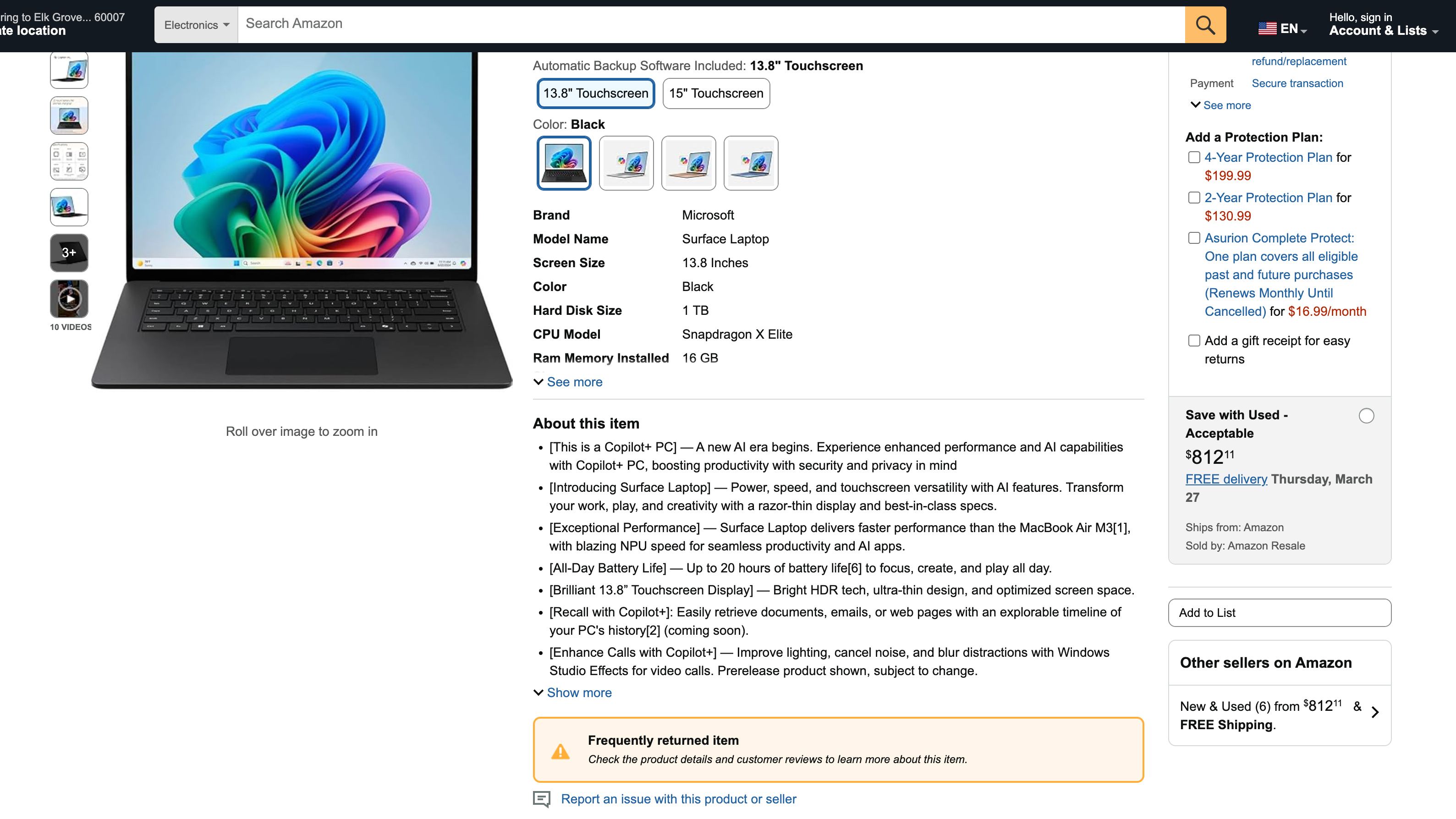‘Frequently returned item' warning slapped on Snapdragon X-powered Surface Laptop 7 at Amazon
Software compatibility issues may be a factor in the higher return rate.

Amazon has flagged Microsoft's Surface Laptop 7 as a "frequently returned item," cautioning potential buyers to check customer reviews before purchasing, Windows Central reports. The label suggests that the device has a higher return rate than similar products, though Amazon does not specify the reasons behind it.
One likely factor is the laptop’s use of the Qualcomm Snapdragon X platform, which relies on Arm-based architecture instead of the traditional x86 processors from Intel and AMD. While Arm chips offer better power efficiency and battery life, they can introduce software compatibility issues.
Many Windows applications are still optimized for x86 processors, meaning they must rely on software emulation to run on Arm. Although Microsoft has improved emulation with Windows on Arm, specific older applications, professional software, and games may still suffer from reduced performance or fail to run altogether. This limitation has been a common criticism of Windows devices powered by Arm chips.
The situation for gaming is also not ideal. Many games refuse to even run on Windows on Arm platforms, and those that do often offer lower performance than competing x86 platforms. Also, it bears mentioning that Snapdragon's primary selling point was originally centered around far superior battery life over x86 alternatives.
Newer x86 laptops from Intel, like Lunar Lake, have dramatically improved battery life compared to prior-gen models, reducing or eliminating Snapdragon's battery life advantage while preserving full compatibility with Windows software.

The Surface Laptop 7 has a 4.2-star rating on Amazon from over 360 reviews, but 12% of those reviews are one-star. While some users report a positive experience, complaints about software compatibility, performance inconsistencies, and general usability appear to be recurring issues. These concerns may explain why the device has received the "frequently returned" warning, as buyers who expect a seamless Windows experience may be disappointed.
Microsoft is expected to address some of these concerns by offering Intel-powered versions of the Surface Laptop. Earlier this year, the company introduced the Surface Laptop and Surface Pro for business customers, powered by Intel’s Core Ultra 200V (Lunar Lake) processors. Similar options will likely be made available for consumer models, though no official timeline has been announced. Switching to Intel chips would remove software compatibility challenges while providing solid battery life and performance.
Stay On the Cutting Edge: Get the Tom's Hardware Newsletter
Get Tom's Hardware's best news and in-depth reviews, straight to your inbox.
Potential buyers of the Snapdragon-based Surface Laptop 7 and Surface Pro 11 should carefully evaluate their software needs. Ensuring that essential programs work correctly on Windows on ARM can help avoid frustration and unnecessary returns.

Kunal Khullar is a contributing writer at Tom’s Hardware. He is a long time technology journalist and reviewer specializing in PC components and peripherals, and welcomes any and every question around building a PC.
-
EzzyB Not even a little bit surprising. There are usage cases for these early ARM Windows machines, but they aren't going to be for everyone until they mature a bit. At least the (larger than you think) crowd that uses Windows and Windows apps on Apple silicon knows what they're getting into. But there are going to be a certain number of people who buy these not realizing exactly what it is that they're buying and run into problems.Reply
I found a lot of Apple enthusiasts who were actually in the Windows Insider program a couple of years ago and when I asked, they replied that it was the only way they could get Windows for ARM so they could run it on their M-series Macs (surprised me at the time.) -
Alvar "Miles" Udell Compatibility is the biggest thing no doubt, but price has to be another large factor. For upwards of $2000 (Snapdragon X Elite Surface Lapop 7 13.8" model with 32GB RAM and 1TB SSD, base price on Amazon, currently $1500 on sale) it's incredibly horrid value. To borrow a chart from TH's sister site Windows Central it's not even the best performing Snapdragon X Elite model, and effectively performs the same as many x86 mobile chips, many of which can be found in cheaper laptops with RTX 4060 or better GPUs and larger screens and/or better battery life.Reply
https://cdn.mos.cms.futurecdn.net/gXhbueuESudQvhurVU278D-1200-80.jpg.webp
Snapdragon based Windows laptops have a market, it's the same market the MacBook Air shares, that is primarily people who will be generally be running a limited selection of apps (Adobe, Office, internet, etc), such as students or people who make presentations or sales pitches. The problem is that while you can get a fairly nice M4 MacBook Air for $1000 where everything works, you have to pay more for a Surface Laptop where everything doesn't .
Also again suggesting Microsoft Surface devices be included in all MacBook Air and Pro reviews and vice versa. -
hwertz Just to point out, fexemu is apparently VERY good, as are the Linux drivers, to the point that you can apparently just throw steam on there and the same games that run on an Intel system run on there.Reply
Since the open source drivers are portable, and Nvidia has had an ARM version of their drivers for over a decade, even an ARM desktop/workstation with video card of choice apparently works well, you can plug in whatever to PCIe, USB, thunderbolt, etc. ports and expect it to work. It does seem a tad unnatural to run an ARM workstation with Intel GPU but it's tested and works (although Nvidia GPU is by far the most common on ones that don't use the integrated Qualcomm or Mali GPU.)
I'm running Ubuntu on a surface now (whatever model came with 7th gen Intel CPU.). It ran everything out of the box but the (weird, using a 7th gen Intel specific camera controller instead of USB) web cam, and the touch screen. I installed a package for adding surface support and those both worked. I turned the screen rez down since running everything at almost 4K then having to run 200% resolution scale to make things big enough seemed silly. and also kicked the crap out of the GPU when gaming. (Deep Rock runs fine with a bit of resolution scaling.) -
Brad1 I love my Surface Pro 11, but I wouldn't blanket recommend it to everyone because the software compatibility concern is real. It fits my needs, which is a PC that has a crazy long battery life (in actual use!) and doesn't sound like a jet engine. I can use my iPhone charger. For gaming and 3D rendering I switch to a tower with a giant Nvidia card.Reply
My Razer laptops were the most versatile, but the weight, power consumption, and noise were a constant frustration. Useless on a plane because the battery life is non-existent and the wattage is too high for a plane outlet.
The only software I'm annoyed about is Adobe Bridge. Pretty much everything else I use works. I was surprised it even handles SketchUp with complicated 3D scenes. -
AnandHulk Compatibility and reliablity are my number 1 "must have otherwise it's a deal breaker right off the bat items" for any computer.Reply
I am a Surface Laptop 2 user and love it. Waiting for a new Surface Laptop to come out with either Lunar Lake or Arrow Lake, although I think I'd prefer Arrow Lake. -
ohio_buckeye I can tell you we purchased a surface pro x with a snapdragon cpu a few months ago because he had an older surface pro and liked the form factor. Software compatibility was terrible. We ended up returning it and purchased a Dell latitude, it may have been the 7350 detachable. But was basically the same form factor and was using Intel CPUs. We’ve since purchased about 3 of those units. Really Microsoft should develop software similar to Apple’s Rosetta. Until that’s done I can’t recommend the new arm CPUs.Reply -
bit_user This high return rate is good for those of us who like good deals on refurb stuff. I was going to sit out this generation of Snapdragon X laptops, but I'd probably have to jump at the right deal on a refurb.Reply
My last laptop was similar. I think it was a store demo model or a return. I got it for less than half of the list price and it worked flawlessly and didn't even have any cosmetic blemishes. It arrived in OEM packaging with accessories, so it seemed legit. -
hwertz Reply
Indeed, I had a Arm Chromebook a few years back (that I threw Chrubuntu on). 22 hour battery life, and 13 hours under FULL load. And it performed very nicely! (It had a Tegra K1 so it had a Nvidia GPU that benched about dead even with a GTX650...unfortunately back then fex didn't exist so some x86/x86-64 stuff ran in qemu but multithreaded apps didn't, so I didn't get to try game after game in wine.) My current machine? 2/3rds the performance of a steam deck, supposedly 3-4 hours battery life but like 45 minutes gaming and MAYBE 1:30 under realistic usage. Ugh.Brad1 said:*cut*
It fits my needs, which is a PC that has a crazy long battery life (in actual use!) and doesn't sound like a jet engine.
*cut*
My Razer laptops were the most versatile, but the weight, power consumption, and noise were a constant frustration. Useless on a plane because the battery life is non-existent and the wattage is too high for a plane outlet.
*cut*
The only software I'm annoyed about is Adobe Bridge. Pretty much everything else I use works. I was surprised it even handles SketchUp with complicated 3D scenes.
If you (the "general you") haven't used a portable that actually runs cool, fast, and huge battery life, you're missing out. I'm really looking forward to picking up a used/refurbed one of these (or new if the price drops plenty) at a good cost and throwing Ubuntu on.
And indeed, the Qualcomm GPUs are apparently VERY good. They're apparently a descendent of the mobile Radeon -- when AMD bought ATI, they spun off the mobile unit and Qualcomm ended up with it. It probably isn't even breaking a sweat in SketchUp. Nicely, apprently the Qualcomm Ardredno Mesa 3D driver is right up to par with the AMD one. -
bit_user Reply
Adreno was the IP from ATI's Bitboys, Oy acquisition. The sale to Qualcomm happened well before even the GCN era. It seems reasonable to expect there was some cross-pollination of ideas & knowledge between the teams, but that's probably the extent of it. Any of that would be far overshadowed by what's happened in the meantime. They were only part of ATI for less than 3 years and Qualcomm got them way back in January 2009.hwertz said:And indeed, the Qualcomm GPUs are apparently VERY good. They're apparently a descendent of the mobile Radeon -- when AMD bought ATI, they spun off the mobile unit and Qualcomm ended up with it. It probably isn't even breaking a sweat in SketchUp. Nicely, apprently the Qualcomm Ardredno Mesa 3D driver is right up to par with the AMD one.
https://en.wikipedia.org/wiki/BitBoys